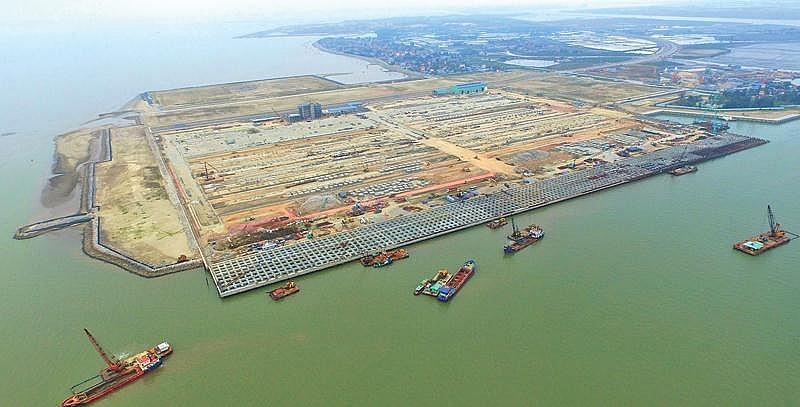First domestic private player HATECO Group joins deep-seaport market
 The Lach Huyen International Gateway Port area
The Lach Huyen International Gateway Port area
Late January 2021, after two weeks of appraising the investment plan of container terminals 5 and 6 at Lach Huyen International Gateway Port area, the Ministry of Planning and Investment (MPI) reported its findings to the prime minister.
Accordingly, the project in the northern port city of Haiphong that was proposed by HATECO Group meets the requirements to be approved in line with the prevailing rules.
“The MPI proposes that the prime minister considers and approves the investment plan of the project in line with the Law on Investment,” stated the report.
To be located on Cat Hai Island belonging to Dinh Vu-Cat Hai Economic Zone, the project costs VND6.425 billion ($279.35 million) and will include two container terminals capable of accommodating vessels of 100,000 deadweight tonnage. The first phase is expected to be carried out by 2025, and the second phase from 2030.
According to Haiphong People’s Committee, if carried out successfully, the project is expected to greatly contribute to the state budget. “More importantly, the project joins the cluster of advanced container terminals accommodating mainline vessels, bringing goods from Northern Vietnam to Europe and North America without transit in Singapore or Hong Kong,” noted a document signed by committee Chairman Nguyen Van Tung and sent to the MPI in December.
The decision is deemed a valuable opportunity for HATECO to invest in two of the six container terminals under Lach Huyen’s 2020-2030 development plan. According to the Ministry of Finance, HATECO has equity of VND5.1 trillion ($221.74 million) and important indicators like return on assets and return on equity are positive, going some way to help meet the investment requirements.
If HATECO officially wins the investment ticket, the group will become the first private-run company in Vietnam to join a local deep-seaport market that has been dominated by foreign investors or state-owned seaport operators in which the state holds controlling stakes.
In 2018, the first two foreign-invested terminals at Lach Huyen International Gateway Port were put into operation through a joint venture between Saigon Newport Corporation, MITSUI O.S.K Lines Ltd. of Japan, Wan Hai Lines Ltd. of Taiwan, and Itochu Group also from Japan, making them the first public-private partnership port project. The venture made conditions for sea transportation between northern Vietnam and neighbouring countries more favourable.
The two other terminals, 3 and 4, are under consideration for approval for Haiphong Port JSC, a member of state-owned shipping giant Vietnam Maritime Corporation, as an investor.
The developments illustrate the strength of Vietnamese firms, with improvements in their financial and professional capacity showing they could compete with strong foreign players in the seaport industry.
According to the Ministry of Transport, investment by world-leading corporations such as Hutchinson, PSA, DP World, and SSA has changed Vietnamese seaports, especially Cai Mep-Thi Vai port. It is now the most attractive segment in the transport sector thanks to its ability to control revenue sources.
Minister of Transport Nguyen Van The told VIR, “Another potential scheme for private investors is Tran De Port, which plays a special and important role in the Mekong Delta region. We are planning to report to the prime minister about this, as some domestic investors have expressed interest in the project.”
A number of international financiers have sought opportunities to invest in Vietnamese seaports in recent times. In 2019, Thailand’s Thoresen Group expressed interest in acquiring a 65 per cent stake in Cai Cui-Can Tho Port in the Mekong Delta city of Can Tho.
Before that, many other investors from Japan, the US, and South Korea have also expressed strong interest in acquiring state stakes in ports in Haiphong, Ho Chi Minh City, and Danang.
At present, over 90 per cent of imports and exports in Vietnam are made via seaports. According to the Vietnam Maritime Administration and the country’s seaport development master plan in 2021-2030 with a vision towards 2050, investment in infrastructure is estimated to require VND100 trillion ($4.35 billion). This will bring about more opportunities for financiers, with domestic and international ventures enjoying equal potential.






